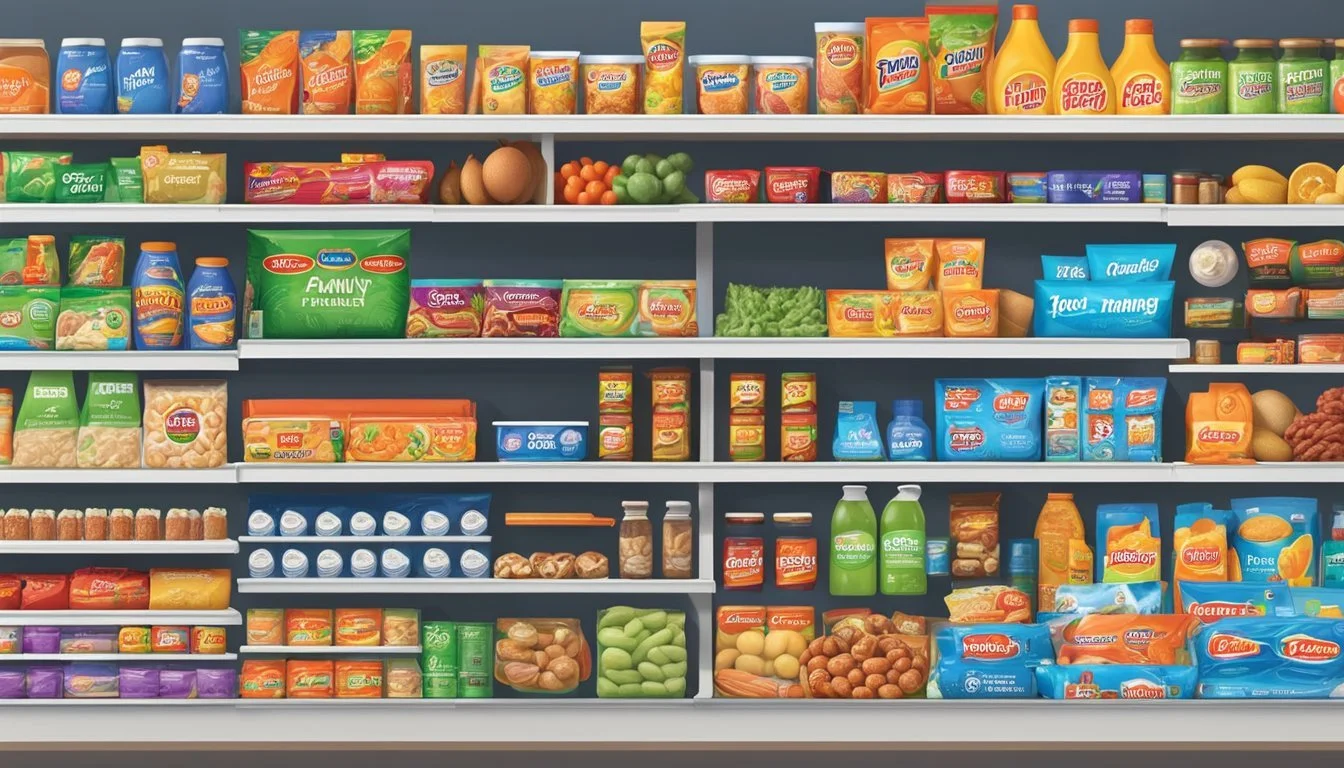Family Dollar vs Five Below
Comparing Prices, Selection, and Value
Family Dollar and Five Below are two popular discount retailers that have gained significant traction in recent years. While both offer budget-friendly options, they cater to different consumer needs and preferences.
Family Dollar focuses primarily on everyday essentials and groceries, while Five Below specializes in trendy merchandise targeted at teens and pre-teens. This fundamental difference in their product offerings sets the stage for a unique comparison between the two stores.
Each retailer has its strengths and weaknesses when it comes to grocery shopping. Family Dollar provides a wider selection of food items and household essentials at competitive prices. Five Below, on the other hand, offers a limited range of snacks and beverages but excels in providing fun, affordable non-grocery items that may appeal to younger shoppers.
Overview of Dollar Stores
Dollar stores have become a significant force in American retail, offering a wide range of products at discounted prices. These chains have seen rapid growth and increasing popularity among consumers seeking value.
History and Business Model
The first modern dollar store, Dollar General, opened in 1955 in Kentucky. These retailers initially sold all items for $1 or less. Today, many have expanded their price points while maintaining a focus on affordability.
Dollar stores typically operate with a low-cost business model. They keep expenses down through efficient supply chains, minimal staffing, and no-frills store designs. This allows them to offer products at lower prices than many competitors.
Most dollar chains carry a mix of consumables, home goods, and seasonal items. Some now include fresh produce and refrigerated foods to compete with traditional grocery stores.
Growth of Dollar Chains in the United States
Dollar store sales in the U.S. grew from $30.4 billion in 2010 to $45.3 billion in 2015. This trend has continued, with major chains rapidly expanding their footprints across the country.
As of 2024, Dollar General, Dollar Tree, and Family Dollar dominate the market. These chains have thousands of locations, often in rural and urban areas underserved by other retailers.
Dollar stores have attracted a diverse customer base. While traditionally associated with lower-income shoppers, they now see increased traffic from middle and higher-income consumers seeking bargains.
The sector faces competition from discount giants like Walmart and online retailers such as Amazon. However, dollar chains continue to thrive by emphasizing convenience and value.
Family Dollar and Five Below Compared
Family Dollar and Five Below offer distinct shopping experiences for budget-conscious consumers. These retailers differ in their product offerings, pricing strategies, and store layouts.
Price Comparison and Affordability
Family Dollar focuses on everyday low prices across a wide range of household essentials. Most items are priced under $10, with many at $1 or less. The store offers frequent sales and discounts on popular items.
Five Below, as its name suggests, prices all items at $5 or less. This pricing model appeals to shoppers looking for affordable trendy items and small luxuries. The store occasionally features special $1-$5 deals on select merchandise.
Both retailers aim to provide value, but their pricing strategies cater to different shopping needs. Family Dollar is better for basic necessities, while Five Below excels in fun, low-cost finds.
Product Range and Brands Offered
Family Dollar carries a diverse selection of household essentials, groceries, and personal care items. The store stocks both name-brand products and its own private labels. Common brands include Coca-Cola, Tide, and Colgate.
Five Below's inventory focuses on trendy accessories, toys, tech gadgets, and room decor. The store carries some recognizable brands but primarily offers its own branded merchandise. Popular categories include phone accessories, beauty products, and seasonal items.
Family Dollar provides a more practical product range for daily needs. Five Below specializes in discretionary purchases and gifts, with a constantly rotating selection of novelty items.
Store Locations and Accessibility
Family Dollar operates over 8,000 stores across the United States, primarily in rural and urban areas. The chain targets locations in lower-income neighborhoods and small towns.
Five Below has a smaller footprint with around 1,000 stores, mainly in suburban areas and shopping centers. The company is expanding rapidly, opening new locations in various markets.
Family Dollar stores are typically more accessible for everyday shopping needs. Five Below tends to be located in areas with higher foot traffic, often near other retail establishments.
Shopping Experience and Store Layout
Family Dollar stores have a no-frills layout, focusing on efficiency. Aisles are organized by product category, with clear signage. The shopping experience is straightforward, emphasizing quick trips for essentials.
Five Below features a vibrant, colorful store design aimed at younger shoppers. The layout is divided into themed sections like "Tech," "Create," and "Party." The atmosphere encourages browsing and discovery.
Family Dollar's approach suits shoppers on a mission for specific items. Five Below caters to those who enjoy exploring and finding unexpected treasures.
Financial Plans and Store Performance
Family Dollar, owned by Dollar Tree, has faced challenges in recent years. The company is working to improve store conditions and streamline operations. Efforts include renovating existing locations and optimizing product mix.
Five Below has shown strong growth, with plans to triple its store count in the coming years. The company's financial performance has been robust, driven by its unique positioning in the discount retail market.
Both retailers are adapting to changing consumer preferences. Family Dollar is focusing on enhancing its core offerings, while Five Below continues to expand its footprint and product range.
Analyzing Product Categories
Family Dollar and Five Below offer distinct product selections tailored to different customer needs and price points. Their inventory spans everyday essentials, food items, personal care products, home goods, and entertainment options.
Essentials and Household Items
Family Dollar focuses heavily on household essentials. They stock a wide range of cleaning supplies, paper products, and kitchenware. Customers can find paper towels, toilet paper, dish soap, and laundry detergent at competitive prices.
Five Below's selection in this category is more limited. They carry some basic household items but emphasize novelty and seasonal products over everyday necessities.
Family Dollar's approach caters to budget-conscious shoppers looking to stock up on essentials. Five Below targets customers seeking affordable extras rather than staples.
Food and Snack Selection
Family Dollar offers a broader range of food options. Their shelves include packaged foods, pasta, coffee, and frozen items. They stock both name-brand and private-label products to provide value at different price points.
Five Below's food selection focuses primarily on snacks and candy. They carry popular chip brands, chocolates, and unique international treats. Their inventory rotates frequently, introducing new and trendy snack options.
Family Dollar aims to be a convenient stop for basic grocery needs. Five Below positions itself as a destination for fun, indulgent snacks.
Personal Care and Beauty Products
Family Dollar provides a comprehensive selection of personal care items. Shoppers can find toothpaste, shampoo, deodorant, and basic cosmetics. They stock both budget-friendly options and well-known brands.
Five Below's beauty section emphasizes trendy and colorful products. They carry fun makeup items, hair accessories, and fragrances targeted at younger consumers. Their selection changes frequently to keep up with current beauty trends.
Family Dollar caters to practical, everyday personal care needs. Five Below focuses on affordable beauty experimentation and self-expression.
Home Decor and Furniture
Family Dollar offers a modest selection of home decor items. They stock basic picture frames, throw pillows, and small furniture pieces like side tables or storage bins. Their focus is on functional, affordable home goods.
Five Below's home decor section is more diverse and trend-driven. They carry colorful room accessories, novelty lighting, and quirky decorative items. Their selection often includes seasonal decor and dorm room essentials.
Family Dollar aims to provide practical home solutions. Five Below targets customers looking to add personality to their spaces without breaking the bank.
Toys, Games, and Crafts
Family Dollar's toy section is relatively small. They stock basic toys, board games, and coloring books. Their selection caters to younger children and emphasizes affordability over variety.
Five Below shines in this category. They offer a wide range of toys, games, and craft supplies. Their inventory includes popular licensed characters, tech gadgets, and creative kits. Five Below frequently introduces new items to keep their selection fresh and exciting.
Family Dollar provides basic entertainment options for children. Five Below positions itself as a destination for affordable fun across all age groups.
Specific Product Evaluations
Family Dollar and Five Below offer diverse product ranges at competitive prices. Their selections vary in quality, brand offerings, and overall value across different categories.
Name-Brand Products vs. Store Brands
Family Dollar carries a mix of name-brand and store-brand products. Their store brands like Family Gourmet and Family Chef provide budget-friendly alternatives. Five Below focuses more on trendy items and carries fewer traditional grocery products.
Family Dollar's store brands often match the quality of name brands at lower prices. Their cleaning supplies and paper products offer good value. Five Below's limited grocery selection consists mainly of snacks and candy, with a focus on popular name brands.
For pantry staples, Family Dollar provides more options. Their store-brand canned goods and dry goods are competitively priced. Five Below excels in novelty snacks and trendy food items, appealing to a younger demographic.
Evaluating Electronics and Accessories
Five Below stands out in the electronics category. They offer a wide range of affordable gadgets and accessories. Their selection includes:
Bluetooth speakers
Earbuds
Phone cases
Charging cables
Family Dollar's electronics section is more limited. They focus on essential items like:
Batteries
Basic headphones
Phone chargers
Five Below's electronics are often of surprising quality for the price. Their headphones and speakers provide decent sound at a low cost. Family Dollar's options are more basic but functional for everyday use.
Clothing and Footwear Offerings
Family Dollar offers practical clothing essentials. Their selection includes:
Socks
Underwear
Basic t-shirts
Affordable shoes
Five Below targets a younger audience with trendier clothing options:
Graphic tees
Accessories like sunglasses and jewelry
Seasonal items like flip-flops and winter hats
Family Dollar's clothing is durable and practical. Five Below's offerings are more fashion-forward but may not last as long. Both stores provide budget-friendly options for different needs and preferences.
School and Office Supplies
Both stores offer competitive prices on school and office supplies. Family Dollar provides a broader range of essential items:
Notebooks
Pens and pencils
Folders
Basic calculators
Five Below excels in fun and trendy supplies:
Colorful notebooks and journals
Novelty pens and pencils
Locker accessories
Desk organizers
Family Dollar's supplies are practical and affordable. Five Below's selection appeals to students looking for more stylish options. Both stores offer good value, with Five Below providing more variety in designs and colors.
Customer Experience and Services
Family Dollar and Five Below offer distinct shopping experiences tailored to different customer needs. Their service quality, policies, and online options shape how customers interact with each brand.
Staff Service and In-Store Assistance
Family Dollar employs staff trained to assist customers with product locations and general inquiries. Stores typically have a more utilitarian layout, focusing on efficiency. Five Below takes a different approach, creating a fun, colorful environment. Their staff often engage more actively with shoppers, especially younger customers. Both chains prioritize quick checkout processes to minimize wait times.
Family Dollar stores may have fewer staff members available during off-peak hours. Five Below tends to maintain a higher staff-to-customer ratio, particularly on weekends and during sales events.
Return Policies and Customer Support
Family Dollar offers a 30-day return policy for most items with a receipt. They provide exchanges or refunds, though some restrictions apply to certain products. Five Below has a more flexible policy, allowing returns within 30 days even without a receipt, offering store credit in such cases.
Both retailers have customer service hotlines for inquiries and complaints. Five Below also provides support through social media channels, often responding quickly to customer issues raised online.
Family Dollar's support focuses primarily on in-store problem resolution. Five Below extends its support to cover both in-store and online shopping experiences.
Online Shopping and Delivery Options
Family Dollar's online presence is primarily informational, with limited e-commerce capabilities. They offer a mobile app for browsing weekly ads and creating shopping lists. Five Below has a more robust online platform, allowing customers to browse and purchase items for home delivery or in-store pickup.
Five Below's website features exclusive online deals and a wider product range than found in physical stores. They partner with major delivery services to ensure timely shipping.
Neither retailer offers grocery delivery services, focusing instead on non-perishable goods for their online offerings.
Marketing Strategies and Customer Perceptions
Family Dollar and Five Below employ distinct approaches to attract and retain customers. Their marketing tactics, brand positioning, and customer engagement strategies shape how shoppers perceive and interact with each retailer.
Promotional Activities and Sales
Family Dollar focuses on everyday low prices and frequent sales promotions. They distribute weekly circulars highlighting discounted items and special deals. The retailer often uses direct mail coupons to drive store traffic.
Five Below takes a different approach, emphasizing its $5-and-below price point as a key selling feature. They run seasonal promotions tied to holidays and back-to-school periods. Five Below utilizes social media heavily to showcase new products and create buzz around limited-time offers.
Both chains leverage their websites and mobile apps for digital coupons and exclusive online deals. This multi-channel strategy helps them reach tech-savvy shoppers and drive both in-store and online sales.
Brand Image and Public Relations
Family Dollar positions itself as a neighborhood store offering essentials at affordable prices. Their messaging emphasizes value and convenience for budget-conscious families. The company sponsors local community events to build goodwill.
Five Below cultivates a trendy, youth-oriented image. Their stores feature bright colors and pop music to create an upbeat shopping experience. The retailer partners with popular brands and social media influencers to stay relevant with their target demographic.
Both chains actively manage their online reputations through customer service responses on review sites and social platforms. They also engage in cause marketing, supporting charities that align with their brand values.
Customer Loyalty and Preferences
Family Dollar's loyalty program offers personalized coupons and rewards based on purchase history. They focus on retaining core customers who rely on their stores for household staples and groceries.
Five Below doesn't have a traditional loyalty program. Instead, they foster customer engagement through an active social media presence and exclusive "Five Below Finds" that create a treasure hunt shopping experience.
Both retailers conduct customer surveys and analyze purchase data to understand shopper preferences. This information guides product selection, store layouts, and marketing campaigns. Family Dollar emphasizes practical value, while Five Below caters to impulse purchases and trend-driven shopping.
Expansion Plans and Future Outlook
Both Family Dollar and Five Below have ambitious growth strategies to increase their store counts and market presence. These retailers aim to capitalize on consumer demand for value-priced products through strategic expansions and new store concepts.
Recent Expansions and Flagship Locations
Five Below has been rapidly expanding its store footprint across the United States. The company plans to open over 200 new stores in fiscal year 2023, driving revenue growth. This aggressive expansion strategy aligns with Five Below's long-term goal of tripling its store count by 2030.
Five Below's management recently increased its target from 2,500 to 3,500 domestic locations by 2030. This ambitious plan would significantly boost the retailer's presence in the U.S. market. The company has also been experimenting with larger flagship stores to showcase its product offerings.
Strategic Goals and Industry Trends
Both Family Dollar and Five Below are adapting to evolving consumer preferences and industry trends. Five Below has introduced higher-priced items in its "Five Beyond" sections to capture additional sales opportunities.
Family Dollar's parent company, Dollar General, is expanding its Popshelf concept to compete directly with Five Below. Popshelf targets a similar demographic with trendy, affordable products.
The discount retail sector continues to grow as consumers seek value. Both retailers are focusing on:
Enhancing in-store experiences
Expanding e-commerce capabilities
Offering a diverse product mix, including pet supplies
Optimizing store layouts and merchandising strategies
These initiatives aim to drive customer traffic and increase sales in a competitive retail landscape.





